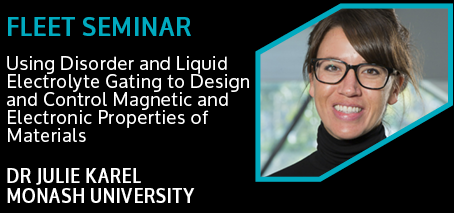-
7 May 2019
11:30 am - 12:30 pm
Dr Julie Karel
Department of Materials Science and Engineering, Monash University
All welcome! The seminar flyer can be downloaded clicking on this link
Abstract
Many research efforts in condensed matter physics and materials science are directed towards developing methods to modify or realize novel materials properties. Some effective tools for doing this include introduction of disorder and application of electric fields; I will highlight examples of these from my own work during this talk. First, I will show that application of an electric field through a liquid electrolyte gate produces significant, non-volatile and reversible modifications in the electronic structure of transition metal oxides. More specifically, I will explain the origin of the low temperature metallicity in VO2 and WO3 thin films after liquid electrolyte gating and offer perspectives for this technique to initiate seemingly contradictory materials properties such as a polar metal. The second part of the talk will demonstrate that disorder can be used to effectively tune the magnetic and electronic properties in FexSi1-x and Fe1-yCoySi thin films; amorphous thin films exhibit an enhanced magnetic moment, enhanced spin polarization and large anomalous Hall effect in comparison to the crystalline material with the same composition. The talk will focus in particular on understanding the origin of the large AHE, which will be shown to depend primarily on the intrinsic mechanism (e.g. an electronic structure effect). This result is surprising because it indicates a local atomic level description of a Berry phase in a system that lacks lattice periodicity. Finally, I will discuss potential applications for amorphous materials in emerging electronic and spintronic devices.
Short Bio
Dr. Julie Karel earned her Bachelor of Science in Materials Science and Engineering from the University of Wisconsin-Madison (Madison, Wisconsin, USA) in 2005. She worked as a Materials Engineer for Intel Corporation for two years before continuing her studies. Julie holds a Master of Science (2010) and a PhD (2012), both in Materials Science and Engineering from the University of California-Berkeley (Berkeley, California, USA). She carried out her postdoctoral work at the Max Planck Institute for Chemical Physics of Solids (Dresden, Germany) with Prof. Claudia Felser from 2012-2016. Julie is currently a Lecturer in the Department of Materials Science and Engineering at Monash University.
Venue: G59-G60, Old Main Building K15
Address:

